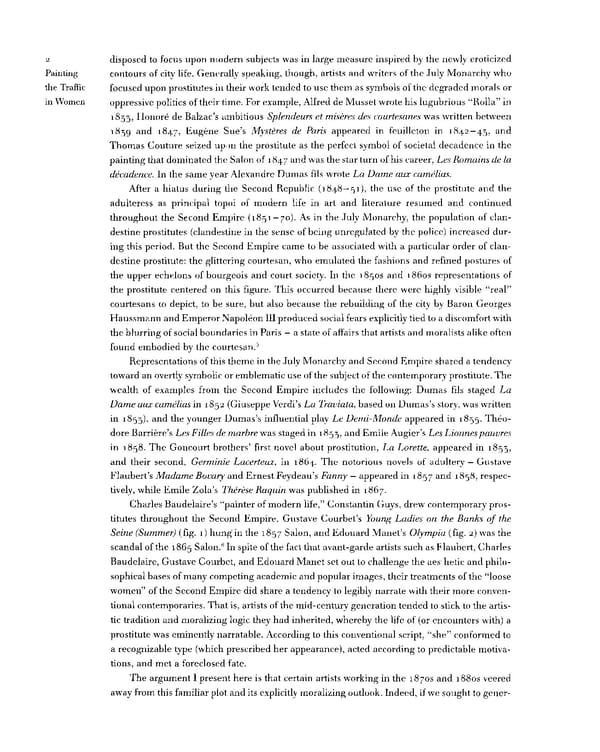2 disposed to focus upon modern subjects was in large measure inspired by the newly eroticized Painting contours of city life. Generally speaking, though, artists and writers of the July Monarchy who the Traffic focused upon prostitutes in their work tended to use them as symbols of the degraded morals or in Women oppressive politics of their time. For example, Alfred de Musset wrote his lugubrious "Rolla" in 1853, Honore de Balzac's ambitious Splendeurs et miseres des courtesanes was written between 1839 and 1847, Eugene Sue's Mysteres de Paris appeared in feuilleton in 1842-43, and Thomas Couture seized upon the prostitute as the perfect symbol of societal decadence in the painting that dominated the Salon of 1847 and was the star turn of his career, Les Romains de la decadence. In the same year Alexandre Dumas fils wrote La Dame aux camelias. After a hiatus during the Second Republic (1848-51), the use of the prostitute and the adulteress as principal topoi of modern life in art and literature resumed and continued throughout the Second Empire (1851-70). As in the July Monarchy, the population of clan- destine prostitutes (clandestine in the sense of being unregulated by the police) increased dur- ing this period. But the Second Empire came to be associated with a particular order of clan- destine prostitute: the glittering courtesan, who emulated the fashions and refined postures of the upper echelons of bourgeois and court society. In the 18505 and i86os representations of the prostitute centered on this figure. This occurred because there were highly visible "real" courtesans to depict, to be sure, but also because the rebuilding of the city by Baron Georges Haussmann and Emperor Napoleon III produced social fears explicitly tied to a discomfort with the blurring of social boundaries in Paris — a state of affairs that artists and moralists alike often 5 found embodied by the courtesan. Representations of this theme in the July Monarchy and Second Empire shared a tendency toward an overtly symbolic or emblematic use of the subject of the contemporary prostitute. The wealth of examples from the Second Empire includes the following: Dumas fils staged La Dame aux camelias in 1852 (Giuseppe Verdi's La Traviata, based on Dumas's story, was written in 1853), and the younger Dumas's influential play Le Demi-Monde appeared in 1855. Theo- dore Barriere's Les Filles de marbre was staged in 1853, and Emile Augier's Les Lionnespauvres in 1858. The Goncourt brothers' first novel about prostitution, La Lorette, appeared in 1853, and their second, Germinie Lacerteux, in 1864. The notorious novels of adultery — Gustave Flaubert's Madame Bovary and Ernest Feydeau's Fanny — appeared in 1857 and 1858, respec- tively, while Emile Zola's Therese Raquin was published in 1867. Charles Baudelaire's "painter of modern life," Constantin Guys, drew contemporary pros- titutes throughout the Second Empire, Gustave Courbet's Young Ladies on the Banks of the Seine (Summer) (fig. i) hung in the 1857 Salon, and Edouard Manet's Olympia (fig. 2) was the 6 scandal of the 1865 Salon. In spite of the fact that avant-garde artists such as Flaubert, Charles Baudelaire, Gustave Courbet, and Edouard Manet set out to challenge the aes hetic and philo- sophical bases of many competing academic and popular images, their treatments of the "loose women" of the Second Empire did share a tendency to legibly narrate with their more conven- tional contemporaries. That is, artists of the mid-century generation tended to stick to the artis- tic tradition and moralizing logic they had inherited, whereby the life of (or encounters with) a prostitute was eminently narratable. According to this conventional script, "she" conformed to a recognizable type (which prescribed her appearance), acted according to predictable motiva- tions, and met a foreclosed fate. The argument I present here is that certain artists working in the 18705 and i88os veered away from this familiar plot and its explicitly moralizing outlook. Indeed, if we sought to gener-
 Prostitution & Impressionists Page 22 Page 24
Prostitution & Impressionists Page 22 Page 24